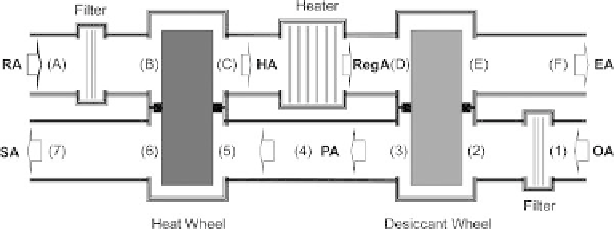Environmental Engineering Reference
In-Depth Information
cooling application, this is done through temperature, compared to industrial appli-
cations of pressure. The processed (dehumidified) air is pre-cooled through, in most
cases, the rotating heat wheel, either through utilization of the cool return air or by
means of outside air. As the air in most cases is still warm for application indoors, final
air cooling is done by means of evaporative cooling, or chill cooling.
The solid desiccant air-conditioning system is the most widely used desiccant air-
conditioning system. This is due to the simple handling of desiccant materials. The
desiccant material is typically impregnated to the honeycomb designed wheels or to
the cross-flow heat exchangers. Although typical solid desiccant materials have higher
regeneration temperatures than liquid desiccants, new materials have been developed
with lower regeneration temperature requirements.
16.3.2 Typical systems
Solid desiccant air-conditioning systems are simpler to use and apply due to the easy
handling of the desiccant material. Hence, the system is not complicated, unlike
liquid desiccant air-conditioning systems in both design and operation. Farooq and
Ruthven (1991) investigated the desiccant bed for solar air-conditioning application.
They showed that the optimal choice of desiccant can be compensated by the appropri-
ate adjustment of the cyclic time. In addition, the cost of making the desiccant wheel
and moisture diffusivity should be given consideration. Jurinak et al. (1984) presented
the open-cycle desiccant air-conditioning system both for ventilation cycle and recir-
culation cycle. They showed that unbalancing the air flow through the dehumidifier
improved the desiccant system coefficient of performance (COP) by 10-15% for the
ventilation cycle and up to 50% for the recirculation cycle. To make the desiccant air-
conditioning system competitive, the thermal COP of the high-performance desiccant
systems must be improved to compete with conventional vapour compression systems,
such as very high heat and mass transfer unit dehumidifiers with large thermal capac-
itance matrix. The most common solid desiccant air-conditioning system is composed
of the two-wheel type, the so-called Munter Cycle shown in Figure 16.3.1. This is the
basic design of the solid desiccant air-conditioning system, in which application of the
air cooling in both the supply air and in the return air is implemented. Hence, several
modifications to this cycle, implementing different operating strategies, are presented
by Henning et al., 2007, Jain et al., 1995 and Henning et al., 1995.
Figure 16.3.1
The double wheels type solid desiccant air-conditioning system (Enteria et al., 2010a).

Search WWH ::

Custom Search